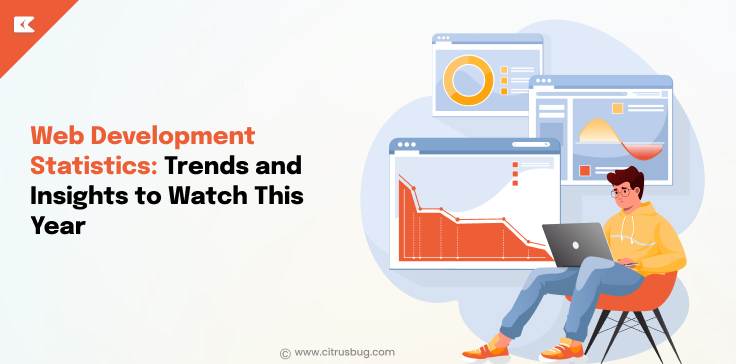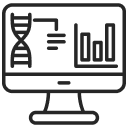Web Development Statistics: Trends and Insights to Watch This Year
- June 30, 2025
-
1978 Views
- by Ishan Vyas

It’s no secret that the internet has become the backbone of our lives, work, and connection. From shopping and learning to banking and entertainment, almost everything we do today is connected to the web in some way. Behind the scenes of all these experiences is one ever-evolving field: web development services. In 2025, staying updated with the latest web development statistics and trends is more important than ever. Technology keeps changing quickly; something that felt modern last year might already seem old today.
We’re seeing huge shifts in how websites are built and experienced. AI is helping developers work smarter. New tools are making it easier to create complex sites without writing much code. And with user expectations rising, businesses are under pressure to build websites that are faster, safer, and more personalized. The good news? The web development growth rate is strong, and there’s more opportunity than ever for developers, designers, and businesses to create amazing digital experiences. In this article, we’ll explore the latest web technology trends, global insights, and industry-specific stats that show where web development is headed next.
Web Development Market Statistics
The web development market is booming. Here are some important numbers that show the current market dynamics:
- The global market for web development is projected to grow from USD 74.69 billion in 2025 to USD 104.31 billion in 2030 with a steady CAGR of 6.91%. The continuous increase in sector services underscores the value of web services for businesses, irrespective of their industry.
- Digital transformation is the backbone of that growth. 65% of companies invest in web development to further digital transformation. This investment trend aligns with 71% of businesses now owning a website, emphasizing its criticality in today’s competitive landscape.
- When it comes to web technology statistics, JavaScript continues to hold the first position among programming languages as it is used by more than 62.3% of developers around the globe. On the front end, the share of the frameworks is increasing; React.js is used by 43% of front-end developers, followed by Node.js (40.8%) and Angular (17.1%).
- The emergence of low-code and no-code development tools is changing the application development processes. According to recent research, almost 70% of new applications are expected to be developed with these technologies by the end of 2025. These trends are lowering the barriers to web creation for non-developers and increasing business turnaround time.
- Regarding further exploration, over 50% of developers are more inclined toward front-end development, which indicates that the interface and experience design remain important for the future of web development.
- The CMS (Content Management System) market is also witnessing sharp growth. The global CMS market is projected to surpass $54 billion by 2025, with WordPress powering 43.6% of all websites globally.
- According to the latest news, entry-level web developers in the US make between $40,000 and $60,000, with strong demand. The number of web developers is set to increase by 8% in the next decade, meaning they will be hired at a similar rate as the average for the job market.
- The most surprising is that 70% of small business websites still do not include a universally accepted call to action, despite all the investments being made in digital marketing strategies. This highlights a distinct lack of focus on optimizing conversion rates.
The intertwining of analysis with facts aids in interpreting the market realities alongside its potential, providing a snapshot of current web technology statistics and what the growth rate of web development means for developers, entrepreneurs, and businesses.
Global Web Technology Statistics by Region
Different regions of the world show different levels of tech adoption. Here’s a look at how web technologies statistics vary globally:
India
India has become a popular place for affordable and high-quality, scalable web application development. The country has more than 5 million software developers, and it is anticipated to surpass the United States in professional developers by 2027.
- According to web development data, India plays a critical role in global outsourcing, as 59% of global businesses outsource their projects to Indian firms.
- The surge of SaaS startups, along with digital-first companies, is creating an increased need for sophisticated and secure websites.
- India holds one of the world’s fastest-growing mobile user bases, which is contributing to a trend of mobile-first development as well as progressive web applications.
United States
The US is at the forefront in tech innovation, adoption of new frameworks, and modern practices of development.
- Recently conducted web development surveys show more than 90% of businesses in the US have a functioning website, making it one of the most digitally connected economies.
- The estimated value of the US web development market exceeds $10 billion, with a strong demand for React, Angular, and headless CMS platforms.
- Web development statistics indicate that the country is ahead in utilizing AI and automation in website development.
United Arab Emirates (UAE)
Rapid digital transformation combined with smart city projects sponsored by the government are positioning the UAE as a leading tech innovation hub in the region.
- The e-commerce market in the United Arab Emirates (UAE) is experiencing remarkable growth, with projections indicating an increase from USD 11.01 billion in 2024 to USD 18.99 billion by 2029. This surge, reflecting a Compound Annual Growth Rate (CAGR) of 11.52%, is fuelled by a range of factors that are transforming the way consumers shop in the region.
- As part of their investment in e-government services, Dubai and Abu Dhabi are also spending heavily on augmented reality, virtual reality, and blockchain technologies for websites related to government and business.
- Given the high penetration of smartphones, responsive Arabic local web design is a major consideration.
Europe
Users in Europe face a stringently regulated as well as an advanced digital environment focusing on data privacy.
- Web development stats from Europe show that 80% of small and medium-sized enterprises (SMEs) have a website.
- In 2023, 45% of businesses across the European Union utilised cloud computing services. The adoption rate was significantly higher among large enterprises, with 78% using cloud solutions, compared to 44% of small and medium-sized enterprises (SMEs). This growth reflects the increasing reliance on emerging technologies like IoT and cloud computing, which are reshaping digital infrastructure and operational efficiency across industries.
- Designs after GDPR compliance have gained focus on privacy, pushing for more considerate ways of handling user data.
Understanding the world’s web development facts and trends requires us to look into different regions. The U.S. and Europe are primarily geared towards innovation and regulation, while India promotes scaling and cost efficiency, and the UAE merges digital opulence with futuristic technology. Regardless of the region, the demand for websites that are smarter, quicker, and more secure is universal.
Website Development Industry Statistics by Sector
Web development is no longer uniform across different sectors. Every industry has its own technological needs, unique users, and specific functionalities. We shall discuss how various sectors are adapting web technologies, along with the latest web development statistics and trends.
Healthcare
The healthcare industry is quickly adopting new technologies, and this shift sped up even more during the COVID-19 pandemic.
- Today, around 73% of patients prefer booking their appointments online, which is pushing hospitals and clinics to improve their websites and patient portals to make things easier and more convenient.
- With the rising demand for telemedicine services and secure patient data handling, there’s an increasing focus on healthcare app development. This surge is driving nearly 11.5% CAGR growth in the digital health tech sector, especially for HIPAA-compliant web applications that ensure both functionality and data privacy.
- For the healthcare industry, security and accessibility have always been and remain critical concerns.
Real Estate
Interactive websites are essential for the real estate sector since they not only showcase properties but also generate inquiries.
- A substantial proportion, over 90% of home buyers, initiate their search through the internet. Thus, real estate agents and brokers heavily rely on websites.
- Standard services now include virtual tours, 3D walkthroughs, and geographically driven search functionality.
- According to recent web development data, real estate businesses that used mobile-first strategies experienced 30% higher engagement than those with legacy websites.
E-Commerce
E-commerce remains one of the fastest-paced sectors in web development.
- In 2026, the volume of global e-commerce is estimated at 8.1 trillion USD. Consequently, there will be a skyrocketing need for secure, fast-to-navigate, and easily scalable websites.
- It has been reported that mobile users are likely to abandon a website if it takes more than three seconds to load, which emphasizes the need for speed optimization.
- Choosing the right web development framework plays a crucial role here, as modern frameworks like React, Vue, or Next.js are specifically designed to enhance performance and ensure faster loading times across devices.
E-Learning
Education platforms are investing more than ever in custom web portals and LMS (Learning Management Systems).
- The global e-learning market is expected to reach $457.8 billion by 2026, requiring strong backend and frontend development support.
- Interactive UI/UX, gamification, and real-time video features are core to successful platforms. Tools like text to video AI also make it easier for e-learning businesses to generate engaging lessons and tutorials at scale, without relying heavily on traditional video production.
- As per a web development survey, platforms with personalized dashboards report a 25–35% higher student retention rate.
Fintech
Fintech startups and institutions are focusing on building secure, compliant, and high-performing web applications.
- 60% of users now prefer using digital banking platforms over visiting physical branches.
- The global fintech app development growth rate is expected to hit 13.5% CAGR through 2030.
- Multi-layered authentication, real-time analytics, and mobile-first dashboards are key deliverables in this space.
Logistics
The logistics and supply chain sector is digitizing rapidly to improve visibility and coordination.
- Around 70% of logistics companies are now using web platforms for tracking, fleet management, and delivery updates.
- Modern logistics sites integrate maps, real-time notifications, and API-based tracking systems. Additionally, the use of AI in logistics is enhancing route optimization, demand forecasting, and real-time decision-making, leading to smarter and more efficient supply chain operations.
- Web development facts suggest that companies with well-integrated logistics portals experience 20–40% improvement in customer satisfaction and delivery accuracy.
Each of these industries reflects a different use case, but the message is the same: a powerful, optimized website is a must. These web development stats prove that sector-specific customization, performance, and support from a UX design agency are no longer optional—they’re mission-critical.
AI-Related Web Development Statistics
The impact of Artificial Intelligence (AI) on the future functionalities of websites and web applications is profound. From automated coding aids to personalization, AI is enhancing efficiency in both the development stages and the user interface. The following are some of the most important takeaways regarding the influence of AI in web development.
The Rise of AI in Web Development
- The construction of modern websites significantly depends on the availability of AI tools. The global AI market for web development is expected to grow to over $50 billion by 2025.
- Over 35% of web developers are actively adopting AI-based coding assistants such as GitHub Copilot and ChatGPT for writing, debugging, and optimizing code, as reported in recent web development statistics.
- In addition, powered website builders WIX ADI and Bookmark are increasingly adopted, particularly amongst non-technical users, thus driving the no-code platform trend.
Personalized Web Experiences
- Web users aged 25 to 34 are the most active, spending an average of 13 hours online weekly, including browsing. AI technologies analyze user activity and engage them with recommended items, including service, content, and product proposals. They expect approximately 74% of online consumers to expect a person-specific offering from the website.
- AI in Marketing tools use personalization technology and AI algorithms to create content for each individual, driving engagement up to 30%.
Smart Analytics and SEO
- AI tools are being used to power real-time website analytics, offering deep insights into user behavior, click patterns, and conversion funnels.
- As per web technology usage trends, over 60% of SEO experts now rely on AI-based tools to optimize web content, keyword targeting, and technical audits, helping white label seo teams boost results.
Chatbots and Customer Interaction
- AI chatbots are incorporated in over 58% of websites for improved customer service in sectors such as e-commerce, banking, and travel.
- These bots resolve more than 70% of basic queries autonomously, cutting down support expenses while enhancing speed for basic query resolutions.
AI and Cybersecurity
- AI-based security systems are being integrated into websites for real-time threat detection, bot blocking, and fraud prevention.
- Research in web technology shows that AI-powered real-time threat detection systems can capture 95% of cybersecurity attacks.
Impact on Developer Workflows
- Incorporating AI into web development tools has decreased the average project time by 25-30%. This enables faster go-to-market launches.
- Web Development statistics show that teams using AI augmented IDEs (Integrated Development Environments) experience 20% fewer bugs at launch compared to traditional setups.
AI is transforming the entire development lifecycle through intelligent coding, accelerated deployment, and improved user experience and security. The trends in the use of web technologies and the emerging statistics in web development confirm that AI is not just a passing trend; it is a permanent fixture in the technology web stack.
Future Trends & Statistics in Web Development
The pace of change in web development is rapid. New trends are coming along with the advancement of technology, which is changing the world of websites:
- More and more businesses are starting to use Progressive Web Apps (PWAs). These apps are becoming popular because they work even without an internet connection and look and feel like regular mobile apps. Experts believe the PWA market will grow a lot, from $5.23 billion in 2025 to over $21.44 billion by 2033.
- Web 3.0 is gaining traction along with Decentralized Applications (dApps). Operating on blockchain networks, these applications are anticipated to transform our interactions with digital information. Adoption of Web 3.0 is already on the rise among startups and industry innovators.
- Headless CMS systems are increasingly preferred by developers. About 40% of developers using headless systems cite enhanced flexibility, scalability, and frontend independence as reasons for their choice. Nevertheless, there is still a significant lag in adoption among content creators and enterprises because of the required technical learning curve.
- The application of blockchain technology in web solutions is redefining them, providing improved security, transparency, and decentralized control, known as Blockchain Development. An increasing number of companies are using blockchains to offer secure payment processing, smart contracts, and digital identity solutions as Web3 adoption increases.
- Web experiences are now integrating Virtual Reality (VR) and Augmented Reality (AR). These immersive technologies will be vital for the retail, real estate, and educational fields as the combined AR/VR market size is projected to reach USD 96.32 billion by 2029.
- The popularity of single-page applications (SPAs) continues to rise because of quick loading times and a seamless user experience. SPAs are gaining popularity with developers as more platforms like Gmail and Facebook adopt them, with usage surpassing 65%.
- Microinteractions and Motion UI design elements are adding to user engagement. Websites that include micro-animations experience as much as a 30% lift in engagement and retention.
- API-first Development is gaining traction as more systems need to be integrated. For tighter backend/frontend separation and quicker market launch, over 68% of developers are adopting API-first workflows. A “State of the API” report shows 74% of developers embrace an API-first approach in 2024, up from 66% the previous year.
These patterns indicate web technology trends and illustrate the growing intelligence, inclusivity, and mobility of the industry.
Conclusion
The domain of web development is changing quickly, and it is imperative to track innovations in web technology. Web solutions are evolving to be more user-centric and expediting processes. For instance, there are now Progressive Web Apps, headless CMS systems, AI software development, and AR/VR immersive technologies. Companies are focusing on tailor-made sites to enhance user experience and drive business growth in sectors such as healthcare, e-commerce, fintech, and real estate. More so, AI is already reshaping the workflows and personalized user engagement in a secure manner, which influences the future of the web. In summary, prioritizing modern web development trends should help companies in the digital world reduce competition.





 SaaS Development
SaaS Development Web Application Development
Web Application Development Mobile Application Development
Mobile Application Development Custom Software Development
Custom Software Development Cloud Development
Cloud Development DevOps Development
DevOps Development MVP Development
MVP Development Digital Product Development
Digital Product Development Hire Chatbot Developers
Hire Chatbot Developers Hire Python Developers
Hire Python Developers Hire Django Developers
Hire Django Developers Hire ReactJS Developers
Hire ReactJS Developers Hire AngularJS Developers
Hire AngularJS Developers Hire VueJS Developers
Hire VueJS Developers Hire Full Stack Developers
Hire Full Stack Developers Hire Back End Developers
Hire Back End Developers Hire Front End Developers
Hire Front End Developers AI Healthcare Software Development & Consulting
AI Healthcare Software Development & Consulting Healthcare App Development
Healthcare App Development EHR Software Development
EHR Software Development Healthcare AI Chatbot Development
Healthcare AI Chatbot Development Telemedicine App Development Company
Telemedicine App Development Company Medical Billing Software Development
Medical Billing Software Development Fitness App Development
Fitness App Development RPM Software Development
RPM Software Development Medicine Delivery App Development
Medicine Delivery App Development Medical Device Software Development
Medical Device Software Development Patient Engagement Software Solutions
Patient Engagement Software Solutions Mental Health App Development
Mental Health App Development Healthcare IT Consulting
Healthcare IT Consulting Healthcare CRM Software Development
Healthcare CRM Software Development Healthcare IT Managed Services
Healthcare IT Managed Services Healthcare Software Testing services
Healthcare Software Testing services Medical Practice Management Software
Medical Practice Management Software Outsourcing Healthcare IT Services
Outsourcing Healthcare IT Services IoT Solutions for Healthcare
IoT Solutions for Healthcare Medical Image Analysis Software Development Services
Medical Image Analysis Software Development Services Lending Software Development Services
Lending Software Development Services Payment Gateway Software Development
Payment Gateway Software Development Accounting Software Development
Accounting Software Development AI-Driven Banking App Development
AI-Driven Banking App Development Insurance Software Development
Insurance Software Development Finance Software Development
Finance Software Development Loan Management Software Development
Loan Management Software Development Decentralized Finance Development Services
Decentralized Finance Development Services eWallet App Development
eWallet App Development Payment App Development
Payment App Development Money Transfer App Development
Money Transfer App Development Mortgage Software Development
Mortgage Software Development Insurance Fraud Detection Software Development
Insurance Fraud Detection Software Development Wealth Management Software Development
Wealth Management Software Development Cryptocurrency Exchange Platform Development
Cryptocurrency Exchange Platform Development Neobank App Development
Neobank App Development Stock Trading App Development
Stock Trading App Development AML software Development
AML software Development Web3 Wallet Development
Web3 Wallet Development Robo-Advisor App Development
Robo-Advisor App Development Supply Chain Management Software Development
Supply Chain Management Software Development Fleet Management Software Development
Fleet Management Software Development Warehouse Management Software Development
Warehouse Management Software Development LMS Development
LMS Development Education App Development
Education App Development Inventory Management Software Development
Inventory Management Software Development Property Management Software Development
Property Management Software Development Real Estate CRM Software Development
Real Estate CRM Software Development Real Estate Document Management Software
Real Estate Document Management Software Construction App Development
Construction App Development Construction ERP Software Development
Construction ERP Software Development




